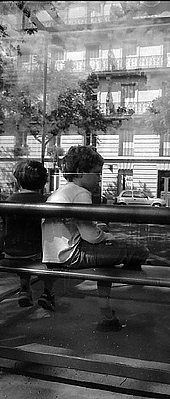New discovery may lead to better bug repellant
新的发现,新的驱蚊剂
Carbon dioxide: We're emitting too much of it in our industrial processes. We're not trapping enough of it in vegetation. Oh, and its presence in our exhaled breath provides mosquitoes carrying maladies like West Nile virus and malaria with a veritable GPS to our bloodstreams. Rockefeller University researchers have identified two proteins expressed by carbon dioxide-sensing neurons in drosophila fruit flies and mosquitoes--a discovery they say could help them design better insect repellants to shield us from the disease-laden bugs.
二氧化碳:我们在工业领域过度排放。我们没有利用植物消耗足够的二氧化碳。哦,存在于我们呼吸中的二氧化碳提供给那些带有如西尼罗河病毒和疟疾的蚊子关于我们血流的准确定位。Rockefeller大学的研究者确认了在果蝇和蚊子的二氧化碳感觉神经中发现了两种蛋白质——他们说这一发现有助于设计更好的防虫剂来保护我们避免携带疾病的病毒。
"Once we show that the mosquito receptors function in the same way as the fly receptors, we take a hint from drug companies--once they have a protein target in mind, [we] can screen for inhibitors of it." says neurogeneticist Leslie Vosshall, the lead author on the study, published in this week's issue of Nature.
"曾经我们发现蚊子的感官功能与苍蝇的感官功能相似,我们从一家制药公司获得了启示——他们曾经考虑到一个蛋白质目标,我们能展现出它的抑制剂。"该项研究的首席专家、神经学家Leslie Vosshall在本周出版的《自然》杂志上作出了上述表示。
It has been known since 2001 that when neurons in the fruit fly's antennae sense carbon dioxide, they release the chemosensory receptor protein Gr21a. Based on her research, and that of others, however, Vosshall knew that insects need two receptor proteins to detect common smells like fruits and flowers. "One of them binds to the smell," she says, "and the other one is critically important to make the [binded protein] function."
人们是在2001年发现它的。当时在果蝇触须的神经系统中发现了二氧化碳,他们释放化学反应感觉器官蛋白质Gr21a。基于她的研究,和其他人的发现,Vosshall获知虫子需要两个感官蛋白质来发现普通气味如水果和花朵。“他们中的一个锁定这个味道”,她说,“另一个则对这个蛋白质发挥功能至关重要。”
By examining other taste receptors in the fly's antennae, Vosshall's team discovered that one particular protein--Gr63a--is coexpressed with Gr21a in both larvae and adults. By genetically engineering flies that only released one of the two proteins, the Rockefeller group determined that a combination of the two is necessary to get the antennae neurons buzzing. For instance, a strain of fly with a mutated version of Gr63a could not detect concentrated carbon dioxide mixtures that normal flies--which are carbon dioxide-averse--would flee from.
通过检测苍蝇触须的其他味觉感觉器官,Vosshall的团队发现一个特别的蛋白质——Gr63a——是在幼虫和成虫的Gr21a蛋白质来共同表达的。通过遗传工程,苍蝇只表现出两个蛋白质中的一个,Rockefeller研究 团队认为两个个蛋白质对于触须神经的嗡鸣是必须的。一种现代有变异版的Gr63a蛋白质的苍蝇不能发现集中二氧化碳的混合物,而普通苍蝇——二氧化碳的厌恶者——会很快逃离。
Vosshall then turned to the mosquito genome to search for genes akin to those of flies. The team found two strong candidates: GPRGR22 and GPRGR24. "They are 62 percent and 48 percent identical, which, in the world of chemosensory receptors, is very similar," Vosshall notes. "There's very little in common between the fruit fly and the mosquito as regards other taste receptors and smell receptors, so these are pretty strongly conserved."
Vosshall 转向蚊子基因组的研究,目的是研究一些苍蝇的基因种群。这个研究小组发现两个强大的候选蛋白质:GPRGR22 和GPRGR24。“他们是62%和48%是同一的。在化学反应感官的领域,他们的机能是相同的,” Vosshall注意到。“关于其他味觉感官和嗅觉感官,在果蝇和蚊子间这种现象是很少见的,所以它们被很好的保存了。”
Unlike the flies, however, mosquitoes have their carbon dioxide-sensing neurons in their maxillary palps (specialized sensory organs located on either side of the insect's proboscis, which the female uses to draw blood from her host). Greg Suh, a researcher at the California Institute of Technology whose lab first identified the fruit fly's carbon dioxide-sensitive neurons, believes the locations of the neurons may explain a major behavioral difference between the insect species: "That's maybe the reason why," he speculates, "mosquitoes are attracted to CO2 whereas fruit flies are repelled by it."
与苍蝇不同。虽然,蚊子在它们的混合触须上有它们的二氧化碳感觉神经。(特别感觉器官位于虫子的两边的嘴上,母虫子常用他们来吸取宿主的血液)。,第一个在实验室里发现果蝇的二氧化碳敏感神经的加州理工大学的研究者Greg Suh相信,这个神经的位置可能解释这个昆虫物种之间的一个主要的不同行为。“这可能就是为什么文字会被二氧化碳吸引,反而果蝇会逃避二氧化碳的原因。”她说。
Vosshall now wants to disable these receptors--at least in the case of mosquitoes--by developing an effective repellant. The current industry-standard compound in bug spray is DEET but, according to Vosshall, no one knows exactly how it works. She believes that her lab will be able to improve on DEET by inhibiting GPRGR22 and GPRGR24. "Whatever we devise would need to be safe, cheap & so that it can be used in the developing world," Vosshall says. "They would have to be the kinds of molecules that would sit safely on your skin, but also form a cloud around you and act on the mosquitoes that are about to bite you." --Nikhil Swaminathan
Vosshall现在希望通过发展一种有效的驱虫剂让这些感官失去功能——至少让蚊子失去功能。目前的工业标准混合在喷雾剂里是DEET,但是,根据Vosshall的研究,没有人准确地知道它是如何工作的。她相信她的实验室将提高DEET通过,抑制GPRGR22 和 GPRGR24蛋白质。“不论我们设计什么,都需要安全,便宜,以便它能用于发展中国家。” Vosshall说。“他们必须是一种能安全停留在我们表皮的分子,还形成一种云雾环绕在你周围,作用于即将叮咬你的蚊子”。




没有评论:
发表评论